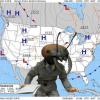Soooooo.... If you know me you know my ant of choice is the Valentine Ant, aka Crematogaster. All summer I had yet to spot a single species of Crematogaster and was becoming increasingly sad while Drew rubbed his 20+ colonies of Crematogasters in my face (yeah, I'm looking at you Drew, YOU BULLY [jokes]). Today was pretty warm so I decided to take a leisurely stroll around my neighborhood woodlot and see what the ant activity was. I noticed only a few select species of ants were out today. For the most part Formicas were still active, there were no Camponotus. I didn't see any Tetramoriums out either and they're usually everywhere you look in the summer. I did see some Myrmicas running around but all the ants seemed really slow.
I bent down to look closer at a Formica worker running through some ground with patches of dead leaves when I noticed some much smaller ants (about 3mm) with pointy bums. I thought "no, can I dare hope?" It turns out that there was an entrance to a Crematogaster cerasi colony under some dead leaves! I GOT WAY TOO EXCITED! I didn't think it was fair to keep all the excitement to myself, so I'm sharing my excitement with you. LET'S BE EXCITED TOGETHER!



Conveniently enough, the tree was marked blue where the colony was. A good landmark to find them again next year when I hunt for Crematogaster queens.
And here is a video I took of some Myrmica doing hibernation excavations. They must be digging further down. I saw the Crematogaster colony was doing the same thing and several other Myrmica colonies around the woodlot were excavating too.
Edited by Mercutia, September 26 2013 - 7:24 PM.


















